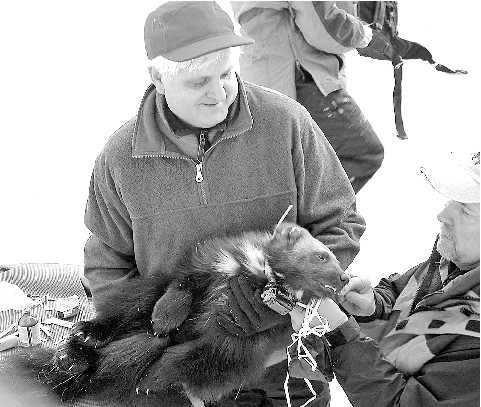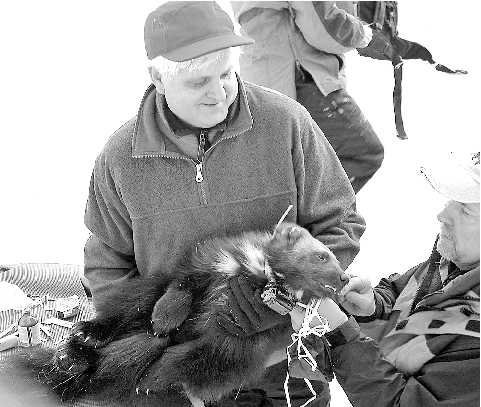Washington Hunter
Well-known member
By Joyce Campbell
Measuring from the tip of her nose to the tip of her tail, the 35-inch wolverine "took off like a streak when they opened the trap."
The young female was the first live-trapped wolverine in Washington, Oregon or California, and she is a good indicator that the species may be residing in the North Cascades.
A team of local Forest Service and state wildlife biologists set out in mid-January to live-trap up to three wolverines this winter.
"We basically had no information, just a handful of observations," said John Rohrer, Forest Service biologist who is leading the team.
There had been sightings in the Harts Pass area and on Highway 20. The elusive carnivore is known to inhabit boreal forests in high mountainous regions.
The team selected three sites based on known sightings, habitat and accessibility for the researchers. Snowmobiles were used to access the Harts Pass, Cutthroat Creek and Twisp River trap sites.
The traps were built using eight-inch logs with the only door being the lid. Wildlife biologist Scot Fitkin helped construct the six-foot by three-foot traps on site. The lids are necessarily heavy, built with three six-foot logs and cross pieces.
The traps are baited with roadkill deer and monitored daily by radio receiver and twice a week by researcher visits. A radio transmitter is attached to the trap. When the trap is sprung, the lid closes and the signal changes.
On Friday (Feb. 10), according to Rohrer, technicians Bruce Akker and Mo Kelly-Akker checked the transmitters on the Harts Pass and Cutthroat traps. Both showed open signals. The schedule called for taking more bait to the Cutthroat site.
On the way back from Cutthroat, they checked the Harts Pass radio and it had a closed signal, so they went up to see what had triggered the trap. Based on what they could see with a flashlight and opening the trap slightly, it appeared to be a wolverine.
The team did not want this one to get away. Forest Service biologist Dan Russell camped overnight to ensure that the powerful, somewhat bear-like creature did not chew its way through the eight-inch logs.
Knowing that they had a wolverine, a process was set in motion to get more experts on the scene. The Forest Service Pacific Northwest Research Station sent project leader Keith Aubrey and his assistant, Kathy Railey.
Jeff Copeland, a wolverine expert from Missoula, came because this was a first capture for this pilot study. He has immobilized and handled probably a couple of dozen wolverines, according to Rohrer.
The team named the young wolverine Melanie. Copeland had missed his granddaughter Melanie’s birthday to work with the research team.
The wolverine was sedated with small amounts of two drugs using a jab stick, said Rohrer.
That gave the researchers 45 minutes to measure, weigh and fit the weasel-like animal with a radio collar and ear tags. The team was hurrying with measuring her paws when the first of the sedations began to wear off, said Rohrer.
The wolverine was put on a pad with wool blankets and an eye sock and administered a drug that reverses the second sedative. She was put back in the trap and the team waited two hours for her to fully recover.
The collar will send radio signals to researchers for 18 months before it is programmed to fall off. The signal is on for five hours, off for 24, allowing monitoring at different times of the day at different locations.
The satellite data will be accessible by agency computer. Project leader Aubrey will access the signal daily to see where Melanie is going and to see what they can learn from her.
They guessed that she is a yearling. She appeared very healthy, said Rohrer. She could still be traveling with her mother.
When the collar falls off, about the time the battery life is ended, a VHF transmitter backup will make it possible to find it. It will be reconditioned and reused.
The Forest Service lists the wolverine as a sensitive species, said Rohrer. The agency is directed to manage to maintain a viable population on the forest and not to do anything to cause a trend toward federal listing under the Endangered Species Act.
The Forest Service will continue to monitor the traps until the end of March, when the bears come out of hibernation, said Rohrer. Bears might steal bait and tear up the traps.
He cautioned recreationists in the area to respect the Do Not Disturb signs if they see a trap.
Measuring from the tip of her nose to the tip of her tail, the 35-inch wolverine "took off like a streak when they opened the trap."
The young female was the first live-trapped wolverine in Washington, Oregon or California, and she is a good indicator that the species may be residing in the North Cascades.
A team of local Forest Service and state wildlife biologists set out in mid-January to live-trap up to three wolverines this winter.
"We basically had no information, just a handful of observations," said John Rohrer, Forest Service biologist who is leading the team.
There had been sightings in the Harts Pass area and on Highway 20. The elusive carnivore is known to inhabit boreal forests in high mountainous regions.
The team selected three sites based on known sightings, habitat and accessibility for the researchers. Snowmobiles were used to access the Harts Pass, Cutthroat Creek and Twisp River trap sites.
The traps were built using eight-inch logs with the only door being the lid. Wildlife biologist Scot Fitkin helped construct the six-foot by three-foot traps on site. The lids are necessarily heavy, built with three six-foot logs and cross pieces.
The traps are baited with roadkill deer and monitored daily by radio receiver and twice a week by researcher visits. A radio transmitter is attached to the trap. When the trap is sprung, the lid closes and the signal changes.
On Friday (Feb. 10), according to Rohrer, technicians Bruce Akker and Mo Kelly-Akker checked the transmitters on the Harts Pass and Cutthroat traps. Both showed open signals. The schedule called for taking more bait to the Cutthroat site.
On the way back from Cutthroat, they checked the Harts Pass radio and it had a closed signal, so they went up to see what had triggered the trap. Based on what they could see with a flashlight and opening the trap slightly, it appeared to be a wolverine.
The team did not want this one to get away. Forest Service biologist Dan Russell camped overnight to ensure that the powerful, somewhat bear-like creature did not chew its way through the eight-inch logs.
Knowing that they had a wolverine, a process was set in motion to get more experts on the scene. The Forest Service Pacific Northwest Research Station sent project leader Keith Aubrey and his assistant, Kathy Railey.
Jeff Copeland, a wolverine expert from Missoula, came because this was a first capture for this pilot study. He has immobilized and handled probably a couple of dozen wolverines, according to Rohrer.
The team named the young wolverine Melanie. Copeland had missed his granddaughter Melanie’s birthday to work with the research team.
The wolverine was sedated with small amounts of two drugs using a jab stick, said Rohrer.
That gave the researchers 45 minutes to measure, weigh and fit the weasel-like animal with a radio collar and ear tags. The team was hurrying with measuring her paws when the first of the sedations began to wear off, said Rohrer.
The wolverine was put on a pad with wool blankets and an eye sock and administered a drug that reverses the second sedative. She was put back in the trap and the team waited two hours for her to fully recover.
The collar will send radio signals to researchers for 18 months before it is programmed to fall off. The signal is on for five hours, off for 24, allowing monitoring at different times of the day at different locations.
The satellite data will be accessible by agency computer. Project leader Aubrey will access the signal daily to see where Melanie is going and to see what they can learn from her.
They guessed that she is a yearling. She appeared very healthy, said Rohrer. She could still be traveling with her mother.
When the collar falls off, about the time the battery life is ended, a VHF transmitter backup will make it possible to find it. It will be reconditioned and reused.
The Forest Service lists the wolverine as a sensitive species, said Rohrer. The agency is directed to manage to maintain a viable population on the forest and not to do anything to cause a trend toward federal listing under the Endangered Species Act.
The Forest Service will continue to monitor the traps until the end of March, when the bears come out of hibernation, said Rohrer. Bears might steal bait and tear up the traps.
He cautioned recreationists in the area to respect the Do Not Disturb signs if they see a trap.






